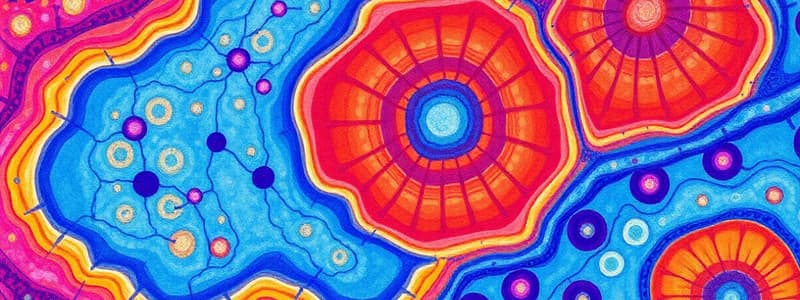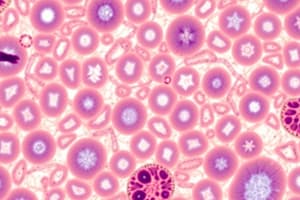Podcast
Questions and Answers
Which type of tissue is characterized by having a high rate of mitosis and being avascular?
Which type of tissue is characterized by having a high rate of mitosis and being avascular?
- Epithelial tissue (correct)
- Connective tissue
- Muscular tissue
- Nervous tissue
Connective tissue is responsible for covering surfaces and lining cavities.
Connective tissue is responsible for covering surfaces and lining cavities.
False (B)
What are the two surfaces of epithelial tissue called?
What are the two surfaces of epithelial tissue called?
Basal surface and apical surface
Epithelial tissue can be classified into _________ epithelia and _________ epithelia based on the number of cell layers.
Epithelial tissue can be classified into _________ epithelia and _________ epithelia based on the number of cell layers.
Match the function of epithelial tissue with its corresponding role:
Match the function of epithelial tissue with its corresponding role:
Which type of cell is primarily responsible for transportation in blood?
Which type of cell is primarily responsible for transportation in blood?
Platelets are full cells that play a role in blood clotting.
Platelets are full cells that play a role in blood clotting.
What is the primary function of neuroglia?
What is the primary function of neuroglia?
The ______ in the blood acts as its ground substance.
The ______ in the blood acts as its ground substance.
Match the following blood cells with their descriptions:
Match the following blood cells with their descriptions:
Which of the following is NOT a type of formed element found in blood?
Which of the following is NOT a type of formed element found in blood?
What is the primary function of dendrites in neurons?
What is the primary function of dendrites in neurons?
Nervous tissue communicates using only electrical signals.
Nervous tissue communicates using only electrical signals.
Skeletal muscle is involuntary and has striations.
Skeletal muscle is involuntary and has striations.
What type of muscle tissue is found only in the heart?
What type of muscle tissue is found only in the heart?
What are the three primary types of formed elements in blood?
What are the three primary types of formed elements in blood?
Endocrine glands secrete hormones directly into the ______.
Endocrine glands secrete hormones directly into the ______.
Match the muscle types with their characteristics:
Match the muscle types with their characteristics:
Which type of muscular tissue is responsible for movements such as digestion and breathing?
Which type of muscular tissue is responsible for movements such as digestion and breathing?
A gland that secretes its product through a duct is known as an ______ gland.
A gland that secretes its product through a duct is known as an ______ gland.
Visceral muscle is a term used to describe skeletal muscle.
Visceral muscle is a term used to describe skeletal muscle.
Which type of gland is the pancreas classified as?
Which type of gland is the pancreas classified as?
Mucous secretion is composed of glycoprotein, mucin, and water.
Mucous secretion is composed of glycoprotein, mucin, and water.
What type of secretion is characterized as thin and watery?
What type of secretion is characterized as thin and watery?
The sweat gland is an example of a __________ gland.
The sweat gland is an example of a __________ gland.
Match the type of secretion with its example:
Match the type of secretion with its example:
Which type of epithelium is primarily involved in rapid diffusion?
Which type of epithelium is primarily involved in rapid diffusion?
Stratified cuboidal epithelium is the most widespread type of epithelium.
Stratified cuboidal epithelium is the most widespread type of epithelium.
What is the primary function of simple cuboidal epithelium?
What is the primary function of simple cuboidal epithelium?
Stratified squamous epithelium is categorized into keratinized and _________ types.
Stratified squamous epithelium is categorized into keratinized and _________ types.
Match the types of connective tissue with their functions:
Match the types of connective tissue with their functions:
Where is simple columnar epithelium primarily found?
Where is simple columnar epithelium primarily found?
The primary function of connective tissue is transport.
The primary function of connective tissue is transport.
What type of cells produce fibers in fibrous connective tissue?
What type of cells produce fibers in fibrous connective tissue?
Simple epithelial tissues are characterized by _______ layer(s) of cells.
Simple epithelial tissues are characterized by _______ layer(s) of cells.
Which type of connective tissue provides physical protection?
Which type of connective tissue provides physical protection?
Flashcards are hidden until you start studying
Study Notes
Introduction to Tissues
- Tissues are categorized into four primary types: Epithelial, Connective, Nervous, and Muscular.
- Histology is the study of tissues at a microscopic level.
- Tissues consist of similar cells that perform specific functions.
Tissue Characteristics
- Differences in tissues arise from cell types, functions, and matrix properties, which include fibrous proteins and ground substance (liquid or gel).
Epithelial Tissue
- Comprised of sheets of cells forming one or more layers.
- Covers surfaces, lines cavities, and forms the majority of glands.
- Avascular and characterized by a high mitotic rate.
Functions of Epithelial Tissue
- Protects against injury and infection.
- Produces secretions and excretes wastes.
- Absorbs substances, filters materials, and detects stimuli.
Structural Features of Epithelial Tissue
- Basal surface faces blood supply; apical surface faces body surface or lumen.
- Classified as simple (one layer) or stratified (multiple layers) based on cell arrangement.
Types of Simple Epithelia
- Simple Squamous: Thin, scaly cells enabling rapid diffusion (locations: alveoli, glomeruli).
- Simple Cuboidal: Square/round cells involved in absorption and secretion (locations: glands, kidney tubules).
- Simple Columnar: Tall, narrow cells often with microvilli, aiding absorption and secretion (locations: GI tract, uterus).
Types of Stratified Epithelia
- Stratified Squamous: Most common type; can be keratinized (resists abrasion) or nonkeratinized (locations: skin, oral cavity).
- Stratified Cuboidal & Columnar: Less common; involved in secretion (locations: sweat glands, ovarian hormones).
Connective Tissue Overview
- Living cells embedded in a non-living matrix, supporting and connecting organs with variable vascularity.
- Provides functions such as binding organs, physical protection, immune protection, movement, storage, and transport.
Fibrous Connective Tissue
- Composed of fibroblasts (produce fibers) and various immune and fat-storage cells.
Blood as Fluid Connective Tissue
- Blood contains plasma (ground substance) and formed elements: erythrocytes (RBCs), leukocytes (WBCs), and platelets (clotting).
Nervous Tissue
- Composed of neurons (nerve cells) and glial cells (supporting cells).
- Neurons transmit information through electrical and chemical signals.
Neuron Structure
- Neurosoma: Cell body containing the nucleus.
- Dendrites: Short extensions receiving signals.
- Axon: Long extension sending outgoing signals.
Muscular Tissue
- Elongated cells specialized for contraction, facilitating bodily movements, digestion, waste elimination, circulation, and heat production.
- Includes three types: Skeletal, Cardiac, and Smooth muscle.
Types of Muscular Tissue
- Skeletal Muscle: Long, multi-nucleated cells with striations, attached to bones, under voluntary control.
- Cardiac Muscle: Branched cells with single nuclei, striated, and interconnected by intercalated discs, involuntary, found only in the heart.
- Smooth Muscle: Fusiform cells without striations, involuntary, found in walls of hollow organs.
Glands
- Structures that secrete or excrete products, primarily composed of epithelial tissues.
- Secretion: Products beneficial to the body, whereas Excretion: Waste products.
Endocrine vs. Exocrine Glands
- Exocrine Glands: Have ducts and secrete substances to surfaces (e.g., sweat glands).
- Endocrine Glands: Ductless, secreting hormones directly into the bloodstream (e.g., thyroid, pancreas).
Types of Secretions
- Serous: Thin and watery (e.g., digestive juices, tears).
- Mucous: Glycoprotein-based, produced by goblet cells (e.g., mucus).
Membranes
- Composed of epithelial and connective tissue, serving various functions including protection and absorption.
Studying That Suits You
Use AI to generate personalized quizzes and flashcards to suit your learning preferences.




